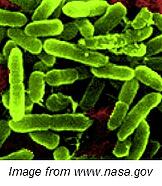blog
April 1, 2011 | Source: Admin User, Inc.
Rapid Micro Detection: Quarterly Microbe Spotlight
POSTED BY Admin User | 4 minute read
April 1, 2011 | Source: Admin User, Inc.
POSTED BY Admin User | 4 minute read
We decided it would be fun to spotlight a different microbe each quarter for both our microbiologist and non-microbiologist readers; Eric Binder, one of our R&D microbiologists, has “volunteered” to kick us off with a microbe of particular interest.
--------------
I remember, as a child, dropping whatever I was eating at the time on the ground, most likely chips, and saying aloud, “ten second rule”. This “ten second rule” was generally accepted by my friends and seemed to get longer as we got older. For instance, I would see a chip on the ground from yesterday, and still eat it, all the while muttering, “ten second rule”; college can be a despite time. Well, my microbiology degree changed all that.
I now know as a microbiologist by the time I picked up that chip, a host of microorganisms had already started colonizing that chip. Most of them are harmless; however, a couple could, under the right circumstances, be harmful. Pseudomonas aeruginosa, found in soil, water, skin flora and on most manmade environments, especially hospital equipment, which definitely makes the harmful list. Avoiding P. aeruginosa is futile. It is all around you in high numbers, especially when you venture outside. Eating that dropped chip at the family picnic becomes all that more thought provoking.
Have no fear, not too much at least; P. aeruginosa is an opportunistic pathogen, which targets victims with underlying conditions such as Cystic Fibrosis, extreme burns across most of the body or chronic lung disease. In healthy individuals, the body’s immune system, a wonder itself, copes with many low level infections. P. aeruginosa likes liquids, and increased levels of can be found in swimming pools that are not properly treated, leading to acute, chronic or life threatening ear infections
conditions such as Cystic Fibrosis, extreme burns across most of the body or chronic lung disease. In healthy individuals, the body’s immune system, a wonder itself, copes with many low level infections. P. aeruginosa likes liquids, and increased levels of can be found in swimming pools that are not properly treated, leading to acute, chronic or life threatening ear infections
Interestingly, P. aeruginosa produces a characteristic pyocyanin pigment which is blue-green and contributes to distinctive blue-green pus associated with wound infections, commonly observed in burn patients. In addition, to identifying phenotypes, P. aeruginosa exhibits a host of virulence factors, such as adhesins (adherence to epithelial cells), Polysaccharide capsule (formation of a biofilm), exotoxin A (blocks eukaryotic protein synthesis), elastase (destruction of elastic fiber) and phospholipase C (breaks down lipids).
P. aeruginosa’s omnipresence and propensity to cause disease is the reason why we monitor it in the pharmaceutical industry. P. aeruginosa may not cause as many infections world wide as Staphylococcus aureus; however, its presence in pharmaceuticals can be drastic. For example, the colonization of P. aeruginosa in a person with Cystic Fibrosis will exacerbate the disease. The chances of a Cystic Fibrosis patient picking up an antibiotic resistant strain in a hospital setting is considerable to begin with; however, to contract an infection through contaminated pharmaceutical products taken for the treatment of the disease would be unthinkable.
The typical test for P. aeruginosa using USP defined incubation times for traditional culture method takes about 24 hours. The Growth DirectTM System for rapid automated microbial detection visualizes this bug in 9-12 hours.
Eric Binder
Microbiologist Research Associate
Rapid Micro Biosystems